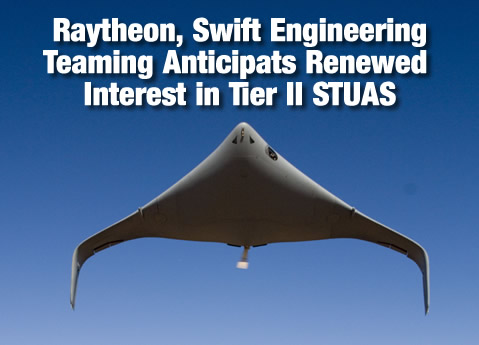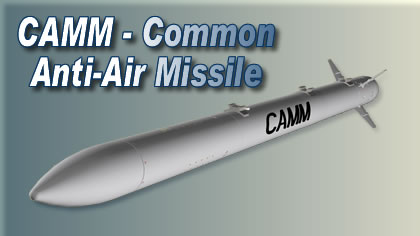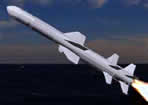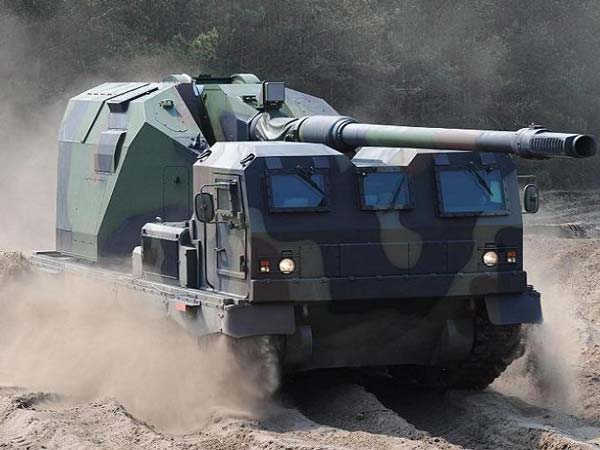Singapore selected the Sniper advanced targeting pod (ATP) to equip its newly acquired fleet of F-16 Block 52 aircraft. Singapore already use the Sniper on its F-15 and part of the F-16 aircraft. The new selection will introduce common support for the entire fleet. Initial delivereies of Sniper pods is expected in 2010. Currently, Sniper ATP is flying on the U.S. Air Force and multinational F-16s, F-15s, B-1, F-18s, Harriers and A-10 and is being integrated on the B-52 aircraft. Sofar Lockheed Martin received orders for Sniper pods from nine international customers.
PICS will Alert Army Units on Incoming Rocket, Missile Attacks
Northrop Grumman Corporation has been selected by the U.S. Army to continue development of the Passive Infrared Cueing System (PICS), an automatic threat warning system designed for ground systems will utilize a two-color uncooled, mid-wave infrared (MWIR), lead selenide passive sensor, capable of locating, cueing, and classifying potential threats from tank fire, rocket-propelled grenades and anti-tank guided missiles. The system will be designed to alert army commanders in a matter of milliseconds of the location of a potential ground-based threat launch to enable defensive systems to effectively neutralize the threat. “With its combination of fast and accurate detection, PICS will fill a key capability for the U.S. military,” said Steve McCoy, Advanced Programs director.”
Under the 20 month, $6 million contract for the second phase of the program, the company will demonstrate 360-degree sensor coverage while on the move at the Army’s Yuma Proving Ground in Yuma, Ariz. The goal is to complete the PICS program with a Technology Readiness Level 6 (TRL-6) system prototype. Northrop Grumman demonstrated a similar capability from a stationary location in a previous phase. The Army has the option to exercise an additional three-year contract valued at $17 million to continue development.
Raytheon, Swift Engineering Team Again to Bid for Future USMC UAV
Raytheon Company (NYSE:RTN) and Swift Engineering, Inc. announced the renewal of their teaming agreement in pursuit of the forthcoming U.S. Navy/Marine Corps Tier II/ Small Tactical Unmanned Aircraft System (STUAS). Two years ago the two companies teamed to compete for an earlier phase which was pushed back by the corps at least untill the next year.
The team, lead by Raytheon, will offer the KillerBee unmanned aerial vehicle, developed by Swift Engineering. Several Raytheon business units will provide products and services for the program, including the ground control system, C4ISR integration, and Mission Support. Optical Alchemy will provide payloads elements for the UAS. The team expects to leverage from extensive work undertaken by Raytheon, developing common Ground Control Systems (GCS), incorporating advancements realized from the development of Raytheon’s Multi-Vehicle Control System, capable of simultaneously controlling multiple, dissimilar vehicles. Based on standard NATO architecture (STANAG 4586) the system supports vehicle flight control and a visual presentation of flight data.
“KillerBee offers the warfighter an affordable unmanned aircraft system, and the Swift Engineering vehicle has both longer endurance and the ability to carry a larger payload,” said Ken Pedersen, Raytheon vice president of Advanced Programs. He noted that the team will offer proven technology to facilitate rapid fielding of the KillerBee in the near term. The KillerBee uses blended wing body design which sets it apart from similar sized unmanned aerial vehicles and is designed to operate ashore or aboard ships with a minimal footprint.
Through extensive air and ground testing, Swift claims that KillerBee has demonstrated performance outperforming any vehicle in its class. Control, processing and display functions were validated, and demonstrated suitability for naval and marine corps applications. The companies plan to continue flight testing throughout 2008, to ensure matured readiness level of the entire KillerBee system. Ongoing flight tests have demonstrated the integrated architecture that includes the hosting of the vehicle specific module in the aircraft mission computer, further validating the STANAG 4586 architecture, and the KJ-640 electro optical-infrared sensor system.
Britain Selects Piranha V for Future FRES Utility Platform
In May 2008 Britain selected the Piranha V vehicle platform, as the Provisional Preferred Bidder for Utility Vehicle Design for its Future Rapid Effect System (FRES) program. Piranha V won after extensive competitive evaluation against the German-Dutch Boxer and French VBCI. The new platform, defined as a medium weight armored vehicle aims to be fielded by 2012 and is expected to replace some of the APCs currently in service with the British Army, including the wheeled Saxon, and tracked FV 430 and CVR(T) armored fighting vehicles. On December 11, 2008 British Defence Secretary John Hutton announced that MoD withdrew General Dynamics (UK)’s provisional preferred bidder status, due to disagreement on commercial terms. The company will have an opportunity to compete in any future Utility Vehicle competition, the minister said. Apparently, one of the major issues in disagreement was that MOD insisted the UK will gain ownership of the design, which GDUK could not accept.

According to General Dynamics, the new platform will offer the protection and mobility to meet the Army’s FRES requirement, together with the necessary growth potential to comply with future challenges. The new platform will be the heaviest variant of the Piranha design, originally developed by the Swiss company MOWAG in the mid 1970s. Over 9,300 Piranha vehicles of different types are operational with world armies today. Once delivered, the UK will be the second largest operator of Piranha variants, after the US (operating LAV-III and Strykers – both variants of the Piranha 8×8).
Piranha V is designed for maximum gross vehicle weight (GVW) of 28 metric tons (62,000 lbs), compared to combat loaded US Army Stryker, fitted with SLAT armor kit which weighs about 20 metric tons (43,000 lbs). The vehicle will be equipped with an uprated power-train, to accommodate the larger weight and power management to customize the increased power demands of a fully digitized platform. While the initial versions will be powered by a diesel engine, General Dynamics is planning to introduce hybrid electrical or full-electric drive as such systems become mature in the future.
 General Dynamics released two images depicting the proposed FRES UV configuration of the Piranha V. The vehicle shows a homogenous side armor (seemless), sloped front armor (unlike current version using curved design). Two pedestals mounting countermeasures (probably active protection) are also shown. The vehicle also mounts a remote weapon station (Kongsberg Defense Protector).
General Dynamics released two images depicting the proposed FRES UV configuration of the Piranha V. The vehicle shows a homogenous side armor (seemless), sloped front armor (unlike current version using curved design). Two pedestals mounting countermeasures (probably active protection) are also shown. The vehicle also mounts a remote weapon station (Kongsberg Defense Protector).
Among the three finalists, General Dynamics’ package was attractive not only due to its performance and capabilities, but also for its future export benefit. Since the original model is based on a Swiss design, it is free from the restrictions of U.S. export control. The company plans to shift future design and manufacturing to the UK, thus reestablishing AFV production in the UK.
Acquisition of DRS Paves Finmeccanica’s Road to US
Another mega deal reshapes the global map of defense industries – the Italian aerospace and defense group Finmeccanica SpA is ready to offer US$5.2 billion 3.4 billion Euros) for US based DRS. Last week DRS released an announcement it is engaged in discussions contemplating a potential strategic transaction involving the company. DRS and Finmeccanica announced May 13, 2008 that they have signed a definitive merger agreement under which Finmeccanica will acquire 100% of DRS stock for US$81 per share in cash. This transaction represents a premium of 27 percent to DRS’ closing share price on May 7, 2008; it is also a 32 percent premium over DRS’ thirty-day average stock price traded on the NY Stock Exchange.
“Today’s transaction is a perfect fit; the complementary technologies and platforms will establish a new competitive player in defense and security markets in the U.S. and around the world,” said Pier Francesco Guarguaglini, chairman and chief executive officer of Finmeccanica. “The merger furthers Finmeccanica’s tradition of investing in the U.S. and supporting the American warfighter with superior technology and value.”
“DRS’ dramatic growth over the past five years and the premium provided through this acquisition will provide attractive returns for our stockholders,” said Mark S. Newman, chairman of the board, president and chief executive officer of DRS. “This investment in DRS – with an increased emphasis on research and development – will mean the combined company will be able to compete for and win additional contracts around the world, accelerating growth and expanding opportunities at our facilities in the U.S.”
According to Garrick Ngai, defense industry analyst with the Frost & Sullivan Aerospace & Defense Group. Ngai considers Finmeccanica’s Move to be a major opportunity for continued growth for the Italian conglomerate. “Finmeccanica’s acquisition of DRS Technologies will enable the Italian conglomerate to leverage its core competencies in defense electronics and systems with an American leader in the field,” notes Ngai. He considers that following with this acquisition Finmeccanica will be able to introduce its diverse defense portfolio into the U.S., which is by far the largest defense market in the world.
DRS will new markets for the Italian company, within the military, Department of defence and federal agencies. “This is a very smart move by Finmeccanica, as it cannot rely on either the Italian or European defense markets for continued growth.” concludes Ngai.
He considers that following with this acquisition Finmeccanica will be able to introduce its diverse defense portfolio into the U.S., which is by far the largest defense market in the world. DRS will new markets for the Italian company, within the military, Department of defence and federal agencies. “This is a very smart move by Finmeccanica, as it cannot rely on either the Italian or European defense markets for continued growth.” concludes Ngai.
For DRS, the combination with Finmeccanica will enable an American company and brand to better compete in the global military and security market. The transaction will help the new company to bid and win larger-scale projects in the U.S. and abroad.
For Finmeccanica, the transaction will boost its existing position as a top-tier competitor, enabling it to enhance the product and service solutions it provides to its customers. Finmeccanica’s platforms and areas of expertise (helicopters; defense electronics and security; aeronautics; space; defense systems; energy; and transportation) wholly complement DRS’ growing market penetration by its four primary business segments: Command, Control, Communications, Computers & Intelligence (C4I); Reconnaissance, Surveillance & Target Acquisition (RSTA); Sustainment Systems; and Technical Services.
According to the agreement between the companies, DRS will operate as a wholly-owned subsidiary, maintaining its current management and headquarters. DRS will lead Finmeccanica’s defense electronics efforts in the U.S. after the transaction closes. Finmeccanica already operates subsidiaries in Pennsylvania, New York, Texas, California, New Jersey, Kansas, Virginia, North and South Carolina.
Raytheon, Swift Engineering Team Again to Bid for Future USMC UAV
Raytheon Company (NYSE:RTN) and Swift Engineering, Inc. announced the renewal of their teaming agreement in pursuit of the forthcoming U.S. Navy/Marine Corps Tier II/ Small Tactical Unmanned Aircraft System (STUAS). Two years ago the two companies teamed to compete for an earlier phase which was pushed back by the corps at least untill the next year.
The team, lead by Raytheon, will offer the KillerBee unmanned aerial vehicle, developed by Swift Engineering. Several Raytheon business units will provide products and services for the program, including the ground control system, C4ISR integration, and Mission Support. Optical Alchemy will provide payloads elements for the UAS. The team expects to leverage from extensive work undertaken by Raytheon, developing common Ground Control Systems (GCS), incorporating advancements realized from the development of Raytheon’s Multi-Vehicle Control System, capable of simultaneously controlling multiple, dissimilar vehicles. Based on standard NATO architecture (STANAG 4586) the system supports vehicle flight control and a visual presentation of flight data.
“KillerBee offers the warfighter an affordable unmanned aircraft system, and the Swift Engineering vehicle has both longer endurance and the ability to carry a larger payload,” said Ken Pedersen, Raytheon vice president of Advanced Programs. He noted that the team will offer proven technology to facilitate rapid fielding of the KillerBee in the near term. The KillerBee uses blended wing body design which sets it apart from similar sized unmanned aerial vehicles and is designed to operate ashore or aboard ships with a minimal footprint.
Through extensive air and ground testing, Swift claims that KillerBee has demonstrated performance outperforming any vehicle in its class. Control, processing and display functions were validated, and demonstrated suitability for naval and marine corps applications. The companies plan to continue flight testing throughout 2008, to ensure matured readiness level of the entire KillerBee system. Ongoing flight tests have demonstrated the integrated architecture that includes the hosting of the vehicle specific module in the aircraft mission computer, further validating the STANAG 4586 architecture, and the KJ-640 electro optical-infrared sensor system.
Israel Air Force to Install Helmet Displays in UH60, CH53 Helicopters
Some of the Helicopters will be Equipped with Line of Sight Systems, improving situational display and coordination between crewmembers
Elbit Systems Ltd. (NASDAQ:ESLT) announced it has been awarded a contract to supply ANVIS/HUD systems for the Israeli Air Force Blackhawk (“Yanshuf”) and CH 53 (“Yasur”) helicopters. The project is scheduled to be completed within 2009. Part of these systems will implement the new ‘Line of Sight (LOS) control’ feature recently introduced for the ANVIS/HUD, controlling payloads and other systems on board to the pilot’s line of sight.
The new Head-up Display systems will enable the helicopter pilot to fly “head out of the cockpit”, day & night, while having all the flight data projected onto the helmet mounted visor. The display enhances the crew’s situational awareness and thus improves flight safety, particularly in challenging conditions, particularly during formation flight, takeoff and landing such as at night or under bad weather conditions limiting visibility.
The system will implement the new ‘Line of Sight (LOS) control’ feature recently introduced for the ANVIS/HUD, controlling payloads and other systems on board to the pilot’s line of sight. For example, this feature correlates the pilot’s line of sight with on board navigation cues, for designating navigation waypoints, targets, threats or other points of interest with intelligence value along the flight route in real-time.
Additionally, the system improves pilot coordination by allowing each crew member to track the other’s line of sight, eliminating the need for distracting intercome among the crew. To date Elbit Systems delivered over 6,000 ANVIS/HUD systems to various helicopter types.
The company anticipates its new Line of Sight (LOS) feature will be applicable for many of these helicopters. Both attack and tactical transport helicopters have already been supplied wit the systems.
Common Anti-Air Modular Missile family (CAMM)
The U.K. Ministry of Defense envisage the Common Anti-Air Modular Missile (CAMM) family to provide a local area air defence protecting against a broad threat set, characterized by high speed and highly maneuverable subsonic and supersonic fast jets and cruise missiles, as well as helicopters, both operating under heavy countermeasures environment.
MBDA has been involved in preliminary studies to define and develop a common solution for such anti-air target guided weapons, used for naval, land and aerial operations which could be implemented in a future system currently known as CAMM – the Common Anti-air Modular Missile, to be fielded within 7 – 10 years (2015-2018). The missile family considered for CAMM will comprise a common missile and modular standard subsystems utilized across several systems, contributing to cost savings in acquisition and logistical support. Systems design and integration will be based on an open architecture, further contributing to ease of incremental upgrades, eliminating potential future obsolescence in capability, functionality and technology thereby enabling an extended life.
This approach has already been established with the PAAMS (Principal Anti-Air Missile System) naval area defense weapon system. CAMM follows this approach by re-using software and adding new low cost components. For Land and Sea applications the low footprint and low cost Soft Vertical Launch SVL is offered. In the naval application, CAMM could provide timely replacement for the Sea-Wolf missile, whose effective service life with the Royal Navy’s Type 23 frigates will expire in around 2018. The CAMM family is being designed to meet the MoD’s requirement for a Future Local Area Air Defense System (FLAADS) for the Type 23 Frigate and, subsequently, for the Future Surface Combatant. The impact of the new system could be minimized by reusing existing systems, including Command and Control systems. As the new missiles will employ more advanced targeting and missile homing, tracking and illumination radars can be eliminated.
Another derivative of the CAMM family is considered as a successor for the current Rapier weapon system whose effective service life will expire in around 2020. In this role, CAMM will be fielded as a self-sustained stand-alone unit designed for the networked battlefield environment. A future derivative of the system could be used as an upgrade for the current ASRAAM infrared guided missile currently in service with the Royal Air Force. The CAMM solution has evaluated the future need and by utilizing the existing ASRAAM airframe, with its proven high maneuverability, aircraft integration and clearance costs can also be minimized. CAMM will be able to improve over the current ASRAAM capabilities, particularly as it is designed to engage air targets in highly cluttered environments and adverse weather conditions.
An improved version of the AASM is currently undergoing flight qualification by the French DGA. This ‘metric’ AASM’ version is equipped with the standard INS/GPS guidance system employed by the weapon, and an infrared imager that automatically identifies the target several seconds before impact and corrects the trajectory for much more precise Impact, reducing the circular error point from ‘decametric’ to ‘metric’ dimensions. During the second test held In June 2008, the weapon demonstrated the capability to hit the target accurately without the use of GPS. The AASM flew for about 25km relying exclusively on inertial navigation. On the terminal phase the AASM executed course readjustment using the infrared imager to score a direct hit. On a previous test the weapon demonstrated the capability to attack targets from a range of 50km. The ‘decametric’ AASM is already in service in the French Air Force and has been successfully used several times by Rafale fighter planes in Afghanistan.
The Golan Heights Will Remain Israel’s Strategic Bulwark
Ankara’s mediation efforts yielded result on April 24 when Israel announced that it was ready to give up the stategic Golan Heights to Syria for peace, forty-one years after it occupied the area in 1967. It was Turkish Prime Minister Recep Tayyip Erdogan who passed the news to Syrian President on his visit to Damascus. Although this is not the first time, that rumors of concessions to Syria’s presidents abound in Israel, its seems that Israel’s Prime Minister Ehud Olmert has focused on a deal with Damascus to bolster his flagging political stance, which is in constant decline since the 2006 Lebanon War.
But there is growing opposition to Olmert’s move, which is regarded largely as an opportunistic spin, rather than a serious strategic turnabout in the enigmatic relations with Syria. Even in Olmert’s own party there are cabinet ministers who already raised eyebrows. Prominent among these is former IDF chief of staff and defense minister Shaul Mofaz who openly warned, that giving Syria the Golan Heights will mean bringing Iran onto Israel’s most topographically sensitive borders. Syria being a very central and dominant component of the radical axis, any handover of the Golan Heights to them means deploying Iranian military elements, sooner or later, on the Golan Heights overlooking Israel’s vulnerable north. A combined Iranian backed threat, from Hezbollah along the Lebanon border and Iranian bolstered Syrian forces, could present a dangerous threat to engulf the entire Israeli north, with no effective defense line to its West.
Thus, the question is not whether Israel is willing to cede it’s hold on the strategic Golan Heights, but if it can afford to do so, without risking it’s national security – by actually inviting an irreconcilable foe, like a Syria-Iran military combination, to exploit it’s first opportunity to strike a mortal blow on Israel’s north.
Syrian president Bashar Assad cannot be trusted in any way. The young leader worships extremists – like Hezbollah leader Hassan Nasrallah and Iranian president Mahmoud Ahmadinejad – encourages violent means, like brutal assassinations of his opponents in Lebanon and even in his own country. In contrast to his utterly shrewd and ruthless, but extremely politically wise father Hafez Assad, young Bashar asserts his power-base by irresponsible actions, which have already cost his nation most of it’s political and economic assets in Lebanon and, among the Sunni Muslim leaders who had counted Syria as one of their own. Now devoid of their support, Bashar has maneuvered his country as Iran’s subservient nation. To trust such a dubious and dangerous leader would spell sheer disaster to Israel’s security.
But the ultimate reasons for Israel’s not ceding the Golan Heights should be based on geo-stratgic facts: Above the Sea of Galilee rises an escarpment, its height ranging from 800 to 100 meters altitude known as the Golan Heights, towering over the Jordan rift valley to its west. It covers a total area of some 900 square kilometers. These heights are characterized by a ridge of volcanic hills that erupted few thousands years ago, creating a plateau made of layers of hard basalt rocks. This terrain makes cross-country movement difficult. Dominating the area is 2814 meter high Mount Hermon, creating a mountain providing excellent observation of the entire region, up to the Damascus Basin to the east, only some 60 kilometers away. To the west, it also dominates the entire Israeli Galilee, up the Haifa Bay on the Mediterranean.
The so-called “Purple Line” established after the ceasefire that followed the Six Day War, June 10th, 1967 provided an excellent line of defense for Israel, located mostly along the watershed and enabling long range observation posts from a line of volcanic hills, on which the IDF established strategic electronic surveillance stations. On the other hand, from pure strategic view, the same Golan Heights contribute almost nothing to the defense of Syria’s capital Damascus. A glimpse at the map indicates that due to topographical features to its west, Damascus can best be defended along the Awaj River near Sasa and the ‘Leja’, the volcanic stony deserts to the south, both impassable to military traffic. Any defense further west, including the Golan Heights can be outflanked, as the IDF did during the latter stages of the 1973 Yom Kippur War.
Furthermore, there is also another highly critical element to be considered – Israel’s vital water supply sources. Although the core issue of the Arab-Israeli conflict has always been the Palestine question, water has been a continuous matter of dispute that is intrinsically linked to it because half of Israel’s water demands are being met outside of its internationally recognized borders. Indeed, water has become a major factor in all past disputes, especially over the Golan Heights. Thus, any serious peace negotiations with Syria must eventually focus on Israel’s price tag over its irreplaceable water resources on the Golan Heights.
The geographical facts are stark and simple: The Golan water-shed is the source for more than 55 percent of Israel’s fresh water needs and forms part of the main aquifer-system that supplies Israel with most of their water supply. Together with the Jordan river headwaters originating near the disputed “Sheeba Farms” in south Lebanon, Wazzani springs, the Hasbani and Banyas, are all receiving their main sources from the area of Mt. Hermon. It should be stressed that most of the tributary streams flowing into the Jordan and Lake Tiberias originate on the Golan slopes. As past history conflicts over these water disputes demonstrated, only an Israeli presence in the basins of these streams can assure their continued flow to Lake Tiberias. In contrast to Israel’s irreplaceable water lifeline from the Golan Heights basin to the river Jordan below, Syria obtains approximately 85 percent of the renewable water supplies from two of the Middle-East’s largest rivers – the Tigris and Euphrates flowing through its east and center regions, while and the river Orontes irrigates large parts of northern Syria. Indeed, Syria has an ongoing dispute with Turkey over it’s northern water resources – which in the past nearly came on the brink of war.
Another major element in any future peace negotiations between Syria and Israel will be the dispute over the so-called “Line of 4 June 1967”, depicting the uncharted border that existed before the Six Day War. This issue has become part of the Arab-Israeli peace process lexicon, for years. It encapsulates the extent of the withdrawal demanded of Israel by Syria in the context of any peace treaty. Conceptually, the line of 4 June 1967 was the confrontation line, on the day before the outbreak of the 5 June 1967 war. Here again shortsighted geo-political constraints became a dangerous source of mortal conflict.
Only along one short 15-kilometer stretch did this dubious line correspond with the international boundary between Palestine and Syria instituted by Great Britain and France in 1923. Neither did it correspond to the mutually agreed UN brokered Armistice Demarcation Line agreed to by the parties in 1949, after the first Arab Israeli war. In fact, the root of the Arab-Israeli water issue can be traced back to 9 March 1916, when the Sykes-Picot Agreement was signed between the British and the French
The Syria-Palestine boundary (later Israel) itself was a product of the post World War I Anglo-French partition of Ottoman Syria. It was intentionally demarcated so that all of Lake Tiberias, including a ridiculous “ten-meter wide” strip of beach along its northeastern shore, would stay inside Palestine. Under the terms of an armistice signed on 20 July 1949, Syrian forces were to withdraw east of the old Palestine-Syria boundary. Israeli forces were to refrain from entering the evacuated areas, which would become a demilitarized zone. However, following incessant armed clashes over these territorial ambiguities, Israel, feeling constantly threatened by the dominating Golan Heights over the Jordan Valley rift, started a creeping annexation of the disputed territory, which ended only with the occupation of the entire Golan Heights after 1967. Israeli claimed sovereignty over Demilitarized military zone (DMZ), on the basis that, “it was always part and parcel of the British Mandated Territory”. The conflict over the Golan waters culminated in 1964, when Syria decided, unilaterally, to tap two of the sources Jordan river sources, diverting the Hasbani and Banyas from their natural flow into Israel, leading their waters to a planned reservoir on the Yarmouk river, on their southern border with Jordan. Israel immediately retaliated sharply by armed force destroying the Syrian construction first by long-range precision tank fire and later, as the Syrians shifted their work further eastward, with massive air-strikes. A few years later the Six Day War broke out, capturing the Golan Heights in June 1967.
Even this strange distinctiveness is not the only anomaly in this highly sensitive region. Due to its geo-strategic topography, Israel’s northern border poses some serious challenge to its defensive posture. What is known as the “Galilee Panhandle”, an area which pokes like a finger from the Hula valley northward up to the Lebanese border, is a curious geographical phenomenon, created as result of hasty, shortsighted decisions made by the French and British planners, following their victory over the Ottoman empire after WW1. The facts of this political fiasco are apparent to even the most impartial observer. On its west, the Panhandle leans on a mountain range, only partially under Israeli sovereignty, the rest is Lebanon. (Over this very ground was fought last summer’s Second Lebanon War, with disastrous consequences, partly due to topographical constraints.) Merely five to seven kilometers in width along its northern part, the Panhandle is dominated on its east by the towering Golan Heights and Mt. Hermon, from which, Israeli villages were constantly bombarded by Syrian artillery located on the overlooking slopes.
Under the present circumstances prevailing in this region, should Israel deprive itself of its most important strategic asset for a mere piece of paper, signed by a single leader, would be a strategic mistake, having serious consequences to any future negative change in Middle Eastern affairs. In fact, Syria’s national interests are focused not only on the Golan Heights, which represent only an insignificant part of its entire territory. Syria’s long-term strategic aims are to exert its hegemony over Lebanon and Israel’s northern territory and even part of northern Jordan, which it considers part of their strategic aspirations over “Greater Syria” predominance.
One of the options being proposed by the Baker-Hamilton report is to place US forces to mentor a future Syria-Israel peace deal over the Golan Heights, following Israel’s withdrawal. Part of this would be US experts taking charge of the IDF monitoring stations on Mt. Hermon and the overlooking border hills. As real-time intelligence in modern warfare is regarded imperative in early warning relinquishing these highly strategic assets, even under a friendly monitored replacement could become a crucial matter of national security. For example, During Operation Desert Storm, US intelligence on Iraqi Scud launch zones in western Iraq, vital to Israel, was denied even when Saddam’s missiles impacted on Tel Aviv. But there are other reasons for Israel’s reluctance to place US forces on the Golan. The presence of US forces in harms way to guard Israel against hostile infiltrations and subsequent preventive counter-guerrilla operations by the IDF could lead to unnecessary tension between the two allied nations.
In conclusion, the Golan Heights represents a vital strategic asset for Israel’s security, especially in view of the current political developments in the region. The danger of the so-called Shi’ite Crescent engulfing Israel from its north and north-eastern border, with a Hezbollah dominated and Iranian-backed Lebanese Government, places Israel, should it cede the Golan Heights to Syria, before a strategic disaster: a potential confrontation on indefensible borders, with a Syrian-Iranian-Hezbollah military alliance. Thus apart from being defensive in its nature, the Golan Heights not only safeguards Israel’s north, but deters, by the IDF long range reach into the Damascus basin, to deter any offensive options, which Bashar Assad may consider to regain the Heights by force even under an Iranian umbrella, will become a highly dangerous adventure.
Personal Positioning System
Draper developed the Personal Positioning System (PPS) in response to the US Army requirement for Personal Navigation System, required to provide autonomous, uninterrupted position, location and attitude reference in GPS-challenged signal environment.
This robust suite is currently in prototype phase. As it is moved into production, the size, power and packaging are expected to improve by an order of magnitude or higher, improving usability and decreasing weight.
Using MEMS inertial devices for measurement, Draper’s PPS uses GPS, inertial, Doppler radar, barometer and magnetometer inputs, to enable the GPS receiver to maintain satellite lock for longer periods in areas where GPS signals are attenuated, screened (by tree canopy) or blocked by (in an urban canyon, for example).
It will also sustain navigation accuracy In areas where GPS signals are absent. The system provides measurement accuracy within 3-5 meters, depending on the distance from last GPS reading. PPS is part of the Future Force Warrior system and is implemented withinthe General Dynamics’ Fusion system.
Airborne Tactical Laser (ATL)
The Airborne tactical Laser is a Special Operations Command (SOCOM) sponsored Advanced Concept Technology demonstration (ACTD) program, designed to demonstrate the use of high power tactical lasers from an airborne platform.
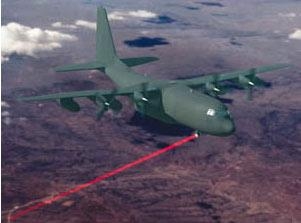 Under the program, a chemical oxygen-iodine laser (COIL) will be installed on a modified C-130H transport aircraft, simulating a future AC-130 laser equipped gunship. The airborne tactical laser will be able to destroy, damage or disable targets at tactical ranges with little to no collateral damage, supporting missions on the battlefield and in urban operations. The laser will be able to place a 10-centimeter-wide beam with enough energy to melt and slice through a metal target from a distance of 15 kilometers. ATL is expected to produce scaleable effects, meaning the weapon operator will be able to select the degree and nature of the damage done to a target by choosing a specific aimpoint and laser shot duration. For example, targeting the fuel tank of a vehicle could result in total destruction of the vehicle, while targeting a tire might result in the vehicle stopping without injury to the driver.
Under the program, a chemical oxygen-iodine laser (COIL) will be installed on a modified C-130H transport aircraft, simulating a future AC-130 laser equipped gunship. The airborne tactical laser will be able to destroy, damage or disable targets at tactical ranges with little to no collateral damage, supporting missions on the battlefield and in urban operations. The laser will be able to place a 10-centimeter-wide beam with enough energy to melt and slice through a metal target from a distance of 15 kilometers. ATL is expected to produce scaleable effects, meaning the weapon operator will be able to select the degree and nature of the damage done to a target by choosing a specific aimpoint and laser shot duration. For example, targeting the fuel tank of a vehicle could result in total destruction of the vehicle, while targeting a tire might result in the vehicle stopping without injury to the driver.
The program is led by Boeing, which is assisted by an industry team including L-3 Communications/Brashear, which made the laser turret, and HYTEC, Inc., which made various structural elements of the weapon system. Boeing began flight testing of a surrogate solid-state laser in October 2006. The aircraft used a surrogate solid-state “low-power” laser for search and track of ground targets. The system utilizes the hardware designed for the high power chemical laser, which includes the beam director and optical control bench, controlling and directing the laser beam to its target; weapon system consoles, which will display high-resolution imagery and enable the tracking of targets; and sensors.
The high power chemical laser destined for the program was also tested for the first time on Sept 21st, the ground, generating the “first light” of the high-energy chemical laser in ground tests. In december 2007, the high power module was installed on the aircraft and by 2008 it is scheduled to fire in-flight at mission-representative ground targets to demonstrate the military utility of high energy-lasers. The test team will fire the laser through a rotating turret that extends through an existing 50-inch-diameter hole in the aircraft’s belly. Future potential ATL platforms could be the C-130 and MV-22 tilt-rotor aircraft.
Autonomous Gun Module (AGM)
Krauss-Maffei Wegmann (KMW) developed the Autonomous Gun Module (AGM), a modular, air transportable unmanned turret which can be installed on various land based and naval platforms. Weighing 12.5 tons, the AGM turret is self contained with a 155mm /39 Caliber gun, automatic loading system and a supply of 30 projectiles and a corresponding amount of charge modules. The AGM fits the dimensions and weight to provide operational mobility with the future A400M transport aircraft. The first AGM system demonstrator has already been implemented on the MLRS chassis which is in service with many NATO countries. The total weight of an MLRS deployed self propelled AGM is 27 tons. AGM uses automatic gun aiming and autonomous loading system, ramming the shell and charges required for the mission. During recent test firings, the system demonstrated a rate of fire of six rounds per minute.
In June 2008 Krauss-Maffei Wegmann (KMW) and General Dynamics European Land Systems (GD ELS) announced a teaming agreement to develop and market a new self-propelled gun called Donar, based on the AGM. The chassis made by GDELS’ is derived from the ASCOD 2 infantry fighting vehicle. A crew of two soldiers (a driver and a commander) operates the entire system from a highly protected driver cabin, increasing survivability and allowing for extremely rapid fire and movement maneuvers. The system, named Donar weighs less than 31 metric tons, allowing it to be transported in the future European Transport Aircraft A400M. A first prototype has already undergone mobility and fire trials at the test facility of the German procurement agency BWB (Bundesamt für Wehrtechnik und Beschaffung). Donar will be unveiled this month at the Eurosatory 2008 exhibition in Paris, France.


 While the Bundeswehr’s current GFF (“protected command and role-specific vehicle”) is being addressed by heavier vehicles, the companies decided to develop a GFF 1/2-class to address evolving requirements. Development costs are being shared by the two partners.
While the Bundeswehr’s current GFF (“protected command and role-specific vehicle”) is being addressed by heavier vehicles, the companies decided to develop a GFF 1/2-class to address evolving requirements. Development costs are being shared by the two partners.
